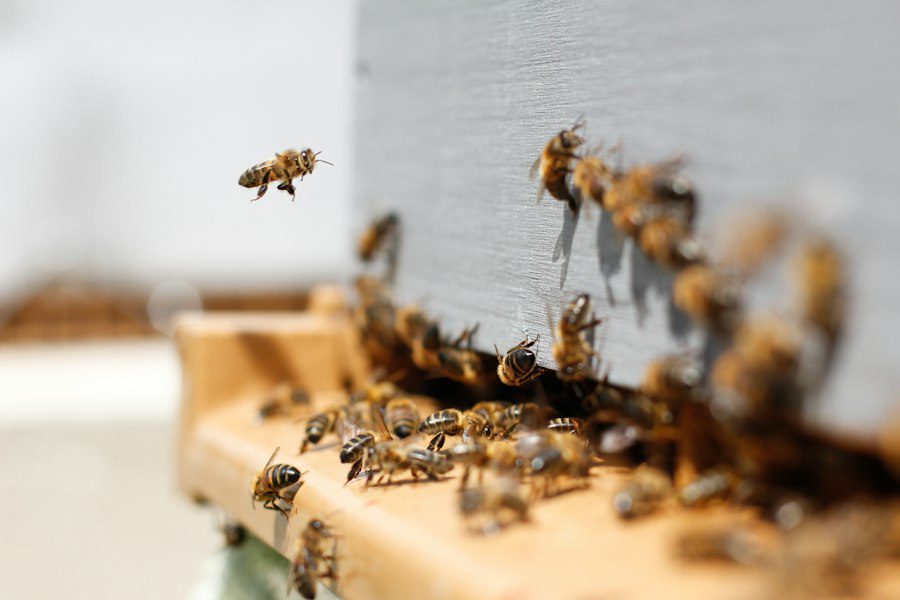Having a bee inside your home can be a nerve-wracking experience. The buzzing sound, the fear of getting stung, and the uncertainty of how to handle the situation can all contribute to a sense of panic. It’s important to understand the dangers and risks associated with bees in order to effectively address the issue and ensure the safety of yourself and your family.
Key Takeaways
- Bees can accidentally enter your home through open windows or doors.
- Having a bee inside can be dangerous, especially for those with allergies.
- Signs of a bee infestation include seeing multiple bees around your home or finding honeycomb.
- DIY bee removal can be dangerous and should only be attempted by professionals.
- Prevent future bee infestations by sealing any cracks or openings in your home.
The Intruder: A Bee in My House
I remember the day vividly when I had a bee inside my house. I was sitting in my living room, enjoying a quiet afternoon, when suddenly I heard a loud buzzing sound. I looked around and saw a bee flying frantically around the room. Panic immediately set in as I tried to figure out what to do. Should I try to swat it? Should I run and hide? The uncertainty of how to handle the situation only added to my fear.
How Did the Bee Get Inside?
Bees can enter a home through various ways. One common way is through open windows or doors. Bees are attracted to light and may be drawn inside if they see it shining through an open window or door. Another way bees can enter a home is through cracks or gaps in the walls or foundation. Bees are small creatures and can easily find their way into even the tiniest openings.
To prevent bees from entering your home, it’s important to take some precautions. Make sure all windows and doors are properly sealed and have screens installed to keep bees out. Seal any cracks or gaps in the walls or foundation of your home to prevent bees from finding their way inside. Additionally, avoid leaving food or sugary drinks uncovered, as this can attract bees.
The Dangers of Having a Bee Inside
| Category | Metric |
|---|---|
| Physical Harm | Number of bee stings |
| Health Risks | Severity of allergic reactions |
| Property Damage | Cost of repairing bee nests |
| Environmental Impact | Disruption of local ecosystems |
Having a bee inside your house may seem harmless at first, but there are potential risks and dangers associated with it. The most obvious danger is getting stung. Bee stings can be painful and can cause allergic reactions in some individuals. If you or someone in your household is allergic to bee stings, it’s important to take immediate action to remove the bee from your home.
Another danger of having a bee inside is the potential for a bee infestation. Bees are social insects and live in colonies. If you have one bee inside your home, there’s a possibility that there may be more bees hiding somewhere. A bee infestation can be a serious problem and may require professional intervention to remove the colony safely.
Signs of a Bee Infestation
There are several signs that indicate a bee infestation in or around your home. One of the most obvious signs is seeing multiple bees entering or exiting a specific area of your home, such as a crack in the wall or a hole in the roof. You may also notice an increase in bee activity around your property, such as bees buzzing around flowers or gathering near a certain area.
Another sign of a bee infestation is finding honeycomb or beeswax in or around your home. Bees build their nests using these materials, so if you come across them, it’s a clear indication that there is a bee colony nearby. Additionally, if you notice an unusual smell, such as a sweet or musty odor, it could be a sign of a bee infestation.
DIY Bee Removal: Is it Safe?

If you have a single bee inside your home, you may be tempted to try and remove it yourself. While this can be done safely in some cases, it’s important to consider the risks involved. Bees can become agitated and defensive if they feel threatened, which can increase the likelihood of getting stung. Additionally, if you attempt to remove the bee without proper knowledge and equipment, you may inadvertently harm yourself or the bee.
If you do decide to remove the bee yourself, there are some precautions you can take to minimize the risks. First, make sure to wear protective clothing, such as long sleeves, pants, and gloves. This will help protect you from getting stung. Second, use a bee-friendly method of removal, such as gently guiding the bee towards an open window or door using a piece of cardboard or a container. Avoid swatting at the bee or using harsh chemicals, as this can harm the bee and increase the chances of getting stung.
Professional Bee Removal: Why You Should Consider It
While DIY bee removal can be done safely in some cases, it’s often best to leave it to the professionals. Professional bee removal services have the knowledge, experience, and equipment necessary to safely remove bees from your home. They can also identify and address any underlying issues that may be attracting bees to your property.
One of the main benefits of hiring a professional bee removal service is that they can ensure the safety of both you and the bees. They have the proper protective gear and know how to handle bees without causing harm. Additionally, professional bee removal services can locate and remove any hidden bee colonies, preventing future infestations.
The Bee Removal Process: What to Expect
If you decide to hire a professional bee removal service, here’s what you can expect during the removal process. First, the professionals will conduct a thorough inspection of your property to locate the bee colony and assess the extent of the infestation. They will then develop a customized plan for removing the bees safely.
Once the plan is in place, the professionals will begin the removal process. This may involve using specialized equipment to safely remove the bees and relocate them to a more suitable location. They will also take steps to prevent future infestations by sealing any entry points and removing any honeycomb or beeswax.
Preventing Future Bee Infestations
After the bee removal process is complete, it’s important to take steps to prevent future infestations. Regular maintenance and inspections of your home can help identify and address any issues that may attract bees. Keep windows and doors properly sealed and install screens to keep bees out. Seal any cracks or gaps in the walls or foundation of your home. Additionally, avoid leaving food or sugary drinks uncovered, as this can attract bees.
Bee-Free Living
Having a bee inside your home can be a stressful experience, but by understanding the dangers and risks associated with bees, you can effectively address the issue and ensure the safety of yourself and your family. Whether you choose to remove the bee yourself or hire a professional bee removal service, taking action is important to prevent further infestations and maintain a bee-free living environment. By following the tips outlined in this article, you can enjoy a bee-free home and peace of mind.
If you’re wondering how a bee managed to find its way into your house, you might be interested in reading an article on pest control tips and tricks. This article provides useful information on how to prevent and deal with common household pests, including bees. Check it out here for expert advice on keeping your home bee-free.
FAQs
What is a bee?
A bee is an insect that is known for its role in pollination and producing honey.
How did a bee get in my house?
Bees can enter a house through open windows, doors, or cracks in the walls. They may also be attracted to sweet smells or flowers inside the house.
Is it common for bees to enter houses?
It is not uncommon for bees to enter houses, especially during the warmer months when they are more active.
What should I do if I find a bee in my house?
If you find a bee in your house, it is best to remain calm and avoid swatting at it. Open a window or door to allow the bee to fly out on its own. If the bee is injured or unable to fly, contact a local beekeeper or pest control professional for assistance.
Are bees dangerous?
Bees are generally not dangerous unless provoked or threatened. However, some people may be allergic to bee stings and can experience severe reactions. It is important to exercise caution around bees and seek medical attention if stung and experiencing an allergic reaction.

